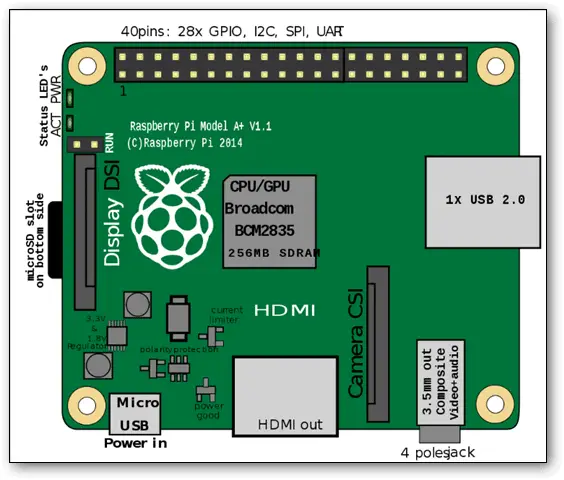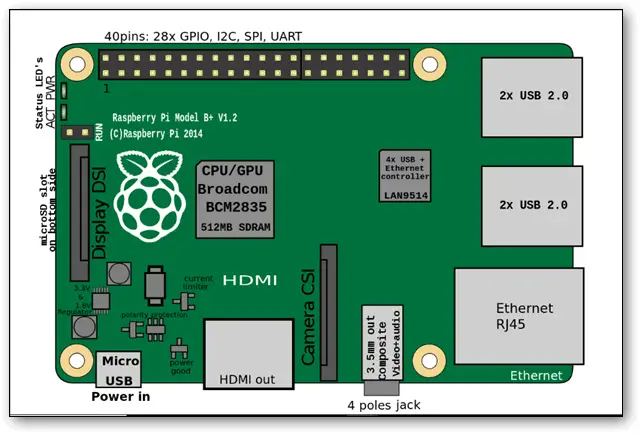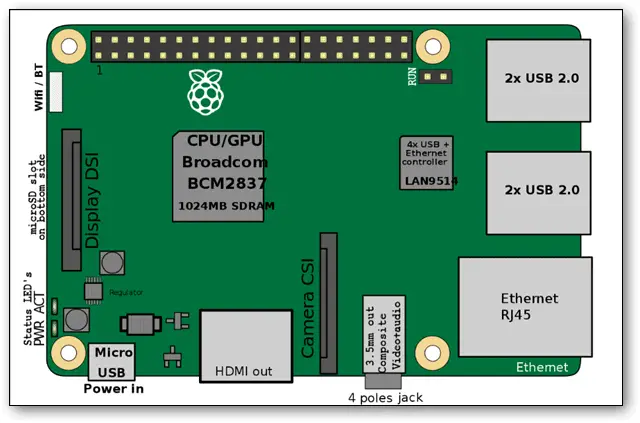There are hundreds of projects that found life from a simple idea on paper, thanks to a feasible Raspberry Pi models. These are used abundantly in schools, education and research institutes and even professional set-ups. Due to its popularity, several Raspberry Pi alternatives have also become quite popular.
The applications of Raspberry Pi are mainly in digital projects, music machines, weather stations, IR cameras, and other exciting electronics projects. Since there are many Raspberry Pi types, here we have a guide that will help you understand the scope of each Raspberry Pi Model better.
See More: Best Raspberry Pi Zero Projects You Can Try Today
What is Raspberry Pi?
When an educational charity launched raspberry Pi, its main intention was to develop a computer science education system for children and adults. It is a tiny credit-card sized computer that is low-cost.
The board can plug into a TV or computer monitor and with the use of a mouse and keyboard give you a machine that is a basic computer desktop. This is mainly used by all to learn how to write a program in a language like Python or Scratch.
It can be used for browsing the internet, playing HD video, playing games, or even to make spreadsheets. The Raspberry Pi is slower than the regular laptop or desktop and uses the Linux operating system.
If you are an enthusiast and keen to experiment with your technical skill by building projects, then Raspberry Pi and its different models are a great option.
The only problem is that you might encounter while proceeding to your project is that you may not know which one will best suit your need.
Raspberry Pi – A Brief History
So here are we identifying the various types of Raspberry Pi Models and see how they are different in their capabilities. This understading will help you to understand the specific boards and choose one for a particular task.
You can buy these in three types – these are Model A, Model B, and Model Zero.
Well, there are several Raspberry Pi models, but they are broadly classified into these three types.
Model B Board
Yes, we are considering Model B first, as Model B was launched followed by Model A.
The Raspberry Pi 1 Model B was released in 2012. Then came Raspberry Pi 1 Model B+ in 2014, an enhanced version of Model B. A year later that is in 2015, Raspberry Pi 2 was launched.
Again, in February 2016, Raspberry Pi 3 Model B was launched with a 64-bit quad-core processor. In October 2016, the v1.2 version of Raspberry Pi 2 released.
Recently, i.e. in 2018, model 3B+ launched with a faster processor and a three times faster network based on Gigabit Ethernet. Here, Model B boards are more powerful than the lighter version that is called Model A.
Model A board
This Model A was released after Model B as a simpler and cheaper version of Model B in 2013. Then a year later, that is 2014, the improved version of Model A came.
Model Zero Board
Since they are already known to be credit-sized computers, the zero version is even smaller than that. Reduced in size and input/output both, Raspberry Pi Zero was released on November 2015 with a cost of just $5.
It gained huge popularity and became the new mainline Raspberry Pi.
The new version was launched. Raspberry Pi Zero W on 28 February 2017 with Wi-Fi and Bluetooth features at $10 only.
One year later, on January 2018, Raspberry Pi Zero WH was launched with pre-soldered GPIO headers.
Primary Raspberry Pi Models
Here are the best of the different kinds of Raspberry Pi comparison in details.
1. Raspberry Pi Model A+
The Raspberry Pi 1 Model A+ comes with 512MB RAM, single USB port, 40 GPIO pins. There is no Ethernet port or Wireless/Bluetooth in this model.
The developers revised the Model A that is discontinued and came up with the A+ version. The improved audio circuit delivers a low-noise power supply.
2. Raspberry Pi Model B+

Raspberry Pi 1 Model B+ has the same SoC and architecture as A+. It is the final version of the original Raspberry Pi with 512MB RAM, four USB ports, 40 GPIO pins, and a 100 Base Ethernet Port.
This is larger with the dimension of 85.6mm x 56.5mm. It introduces a microSDHC slot for high-speed microSD cards.
3. Raspberry Pi 2 Model B
Likewise, Raspberry Pi 2 Model B came in February 2015, which replaced the Raspberry Pi Model B+ with increased RAM of 1GB. This Model B has many features in common with Raspberry Pi 2 Model B like USB ports and Ethernet.
The processor speed increased up to 900Mhz. It features a Broadcom BCM2837 SoC, with a 900MHz 64-bit quad-core ARM Cortex-A53 and the faster CPU and RAM delivers the best performance.
4. Raspberry Pi 3 Model B

In February 2016, the Pi 3 Model B released with 1.2GHz 64-bit quad-core ARM Cortex-A53 CPU, 1GB RAM.
This time it was not only limited to USB Bluetooth and Wi-Fi dongles, but they also included integrated 802.11n wireless LAN, and Bluetooth 4.1.
5. Raspberry Pi Zero Models
A quick Raspberry Pi comparison reveals that Raspberry Pi Zero and Pi Zero W come in half the size of Model A+ that features 1Ghz single-core CPU and 512MB RAM.
It also includes mini-HDMI and USB On-The-Go ports and a camera connector. The Pi Zero W is enhanced with integrated 802.11n wireless LAN and Bluetooth 4.1.
6. Original Raspberry Pi Zero
The original Pi Zero has changed the picture of how Raspberry was launched initially. It is lightweight, and we can say it is a power-packed mini-computer that has great efficiency.
This has 32-bit ARMv6Z architecture and Broadcom BCM2835 SoC similar to Model A and Model B+. It comes with micro USB; one for power and other for data.
Then, this model is equipped with a mini HDMI-out and microSD slot. The CPU is 1GHz single-core ARM1176JZF-S and 512MB RAM.
The 1.3 revision boards also have a camera interface. You will not find GPIO pins, but you can still use them by soldering or manually adding GPIO pins.
Yes, you can do this by using useful kits available in the market.
7. Raspberry Pi Zero W
One problem you could find in this Pi Zero was the limited connectivity which is recovered in Raspberry Pi Zero W.
Now it is equipped with Bluetooth and wireless connectivity, improving the previous version of Model Zero Board.
8. Raspberry PI Zero WH
Raspberry Pi Zero WH is the recent release which was launched at the start of 2018. Overall the features are quite common with previous Pi Zero models, but this time it has GPIO pins.
9. Compute Module
Another release in the array of Raspberry Pi is the Compute Module that is focused on Industrial applications. It can connect to a carrier board like a circuit board inside an industrial product.
In addition, this gives a convenient way for the manufacturers to deploy the Raspberry Pi ecosystem in their own devices. This another way that Raspberry Pi types can be used.
The Raspberry Pi Compute module is used in OTTO, which is a digital camera created by Next Thing Co.
Uses/Application of Raspberry Pi Models
The uses and of Raspberry Pi models are limitless. Many developers and applications are learning to deploy the Raspberry Pi for home automation.
They are also trying to modify the models to deliver a cost-effective solution for energy monitoring and power consumption. Due to its low cost, this has become a new boon in the market as an alternative to expensive commercial solutions.
In 2014, TECHBASE, a Polish industrial automation manufacturer, came up with the world’s first industrial computer based on Raspberry Compute Module named as ModBerry.
Raspberry Pi Zero W can be ideal if you want to develop something with remote access. Raspberry Pi 3 Model B is best suited for learners in schools.
Important points to remember:
- The Model A/A+ has one USB port, Model B has two ports, and Model B+, Pi 2 Model B, and Pi 3 Model B have four ports.
- Raspberry Pi Model B versions measure 85.60mm x 56mm x 21mm, Weight is 45g.
- Pi Zero and Pi Zero W measure 65mm x 30mm x 5.4mm, weight is 9g.
- Raspberry Pi models use Broadcom SoCs along with a Video Card GPU with various ARM CPU cores.
- The default username for Raspbian is “pi and password is “raspberry” (without any quotation marks).
Raspberry Pi Models – Comparision of Prices
The approximate cost, according to the official source for each model, is as follows:
Product and Price
- Raspberry Pi Model A+ $20
2. Raspberry Pi Model B+ $25
3. Raspberry Pi 2 Model B $35
4. Raspberry Pi 3 Model B $35
5. Raspberry Pi Zero $5
6. Raspberry Pi Zero W $10
Conclusion:
So now that you know the different Raspberry Pi models and their potential uses for different kinds of projects, go ahead and choose your best option.
There are multiple uses and applications that can make any amateur or professional designer build products and objects. These can be used for personal or corporate use, depending on the type of project that you undertake.
Further Reading: Unleash The Budding Inventor -With Top 50 Raspberry Pi Project Ideas







